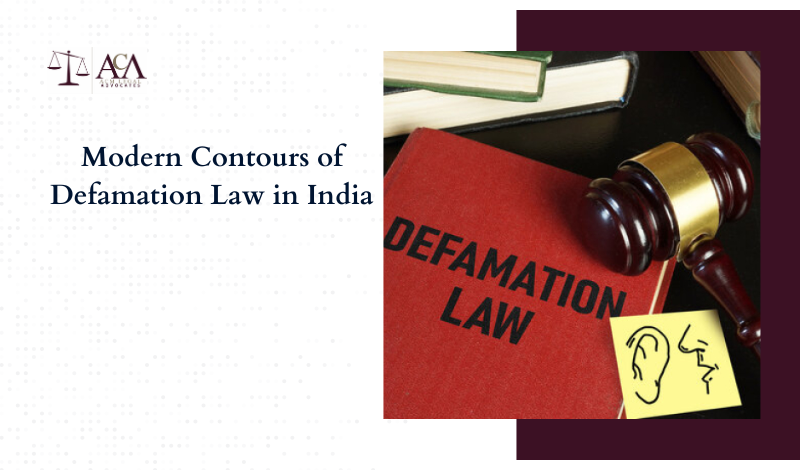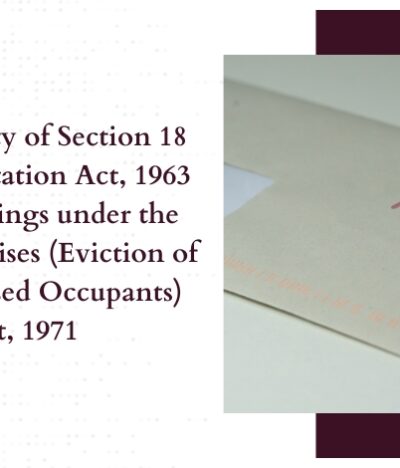Defamation Law in India
In the rapidly evolving media and digital landscape, defamation law in India has gained renewed relevance and scrutiny. The right to reputation, a facet of Article 21 of the Constitution, is increasingly under threat in the age of unverified social media publications and politically motivated narratives. The Delhi High Court, through two landmark decisions—Lakshmi Murdeshwar Puri v. Saket Gokhale [CS(OS) 300/2021] [1] and Rajat Sharma v. Jairam Ramesh & Ors. [CS(OS) 495/2024] [2]—has reiterated the inviolability of reputation and the legal consequences that follow from reckless or malicious publication of defamatory content.
Case Analysis: Lakshmi Murdeshwar Puri v. Saket Gokhale
The plaintiff, Lakshmi Murdeshwar Puri, a decorated diplomat and former Assistant Secretary-General of the United Nations, instituted a civil suit for defamation against the defendant, Saket Gokhale, alleging that a series of tweets issued by him tarnished her reputation and that of her husband, Mr. Hardeep Singh Puri, a Union Cabinet Minister.
Background and Factual Matrix
The offending tweets, published on 13.06.2021 and 23.06.2021 via the defendant’s Twitter handle “@SaketGokhale”, alleged that the plaintiff had acquired a property in Geneva, Switzerland, which was purportedly unaffordable given her and her husband’s declared sources of income. The tweets insinuated financial wrongdoing and called for investigation by the Enforcement Directorate, even tagging the Union Finance Minister. These tweets were widely circulated, with over 26,270 likes and 8,208 retweets.
The plaintiff contended that:
- The statements were false, scandalous, and issued without verification;
- The tweets created malicious imputations about illicit wealth;
- The incident compelled her to disclose personal financial arrangements and the source of funds, including a mortgage from UBS Bank and contributions from her daughter, which would otherwise remain protected under privacy norms.
The tweets also referenced affidavit disclosures made by her husband in Rajya Sabha nominations, mischaracterizing the financial details and misrepresenting them as inconsistent.
Judicial Observations
Justice Bhambhani began the judgement with an epigraph from Shakespeare’s Othello:
“But he that filches from me my good name / Robs me of that which not enriches him, / And makes me poor indeed.”
In a strongly worded decision, the Court held:
- That publication of false imputations without verifying facts constitutes defamation per se;
- That the defendant had not exercised any due diligence and failed to seek clarification from the plaintiff prior to publication;
- That mere reliance on affidavits from the public domain does not exempt a person from liability where insinuations and inferences are drawn and disseminated irresponsibly.
The Court declared the tweets defamatory and passed a decree of:
- Permanent injunction restraining the defendant from posting similar tweets;
- Mandatory injunction directing deletion of the tweets and publication of an unconditional apology;
- Damages of ₹2 crores to be paid by the defendant to the PM CARES Fund;
- Costs of the suit.
Notably, the defendant, after initial participation, was later set ex parte and did not lead evidence, which the Court viewed as a vexatious defence, meriting adverse inference and final adjudication on the strength of the plaintiff’s unrebutted pleadings.
Case Analysis: Rajat Sharma v. Jairam Ramesh & Ors.
Veteran journalist and television anchor Rajat Sharma approached the Delhi High Court seeking protection of his reputation against what he alleged were per se defamatory statements made by political figures from the Indian National Congress (INC)—namely Mr. Jairam Ramesh (Defendant No. 4), Mr. Pawan Khera (Defendant No. 5), and Ms. Ragini Nayak (Defendant No. 6). The case also named major social media platforms X (formerly Twitter), Google (YouTube), and Meta (Facebook) as Defendants Nos. 1 to 3 for hosting the allegedly defamatory content.
Factual Background
The dispute arose from a live televised debate on India TV on 04.06.2024, hosted by the plaintiff. Ms. Ragini Nayak, who was a participant in the debate, later alleged on social media and during a press conference on 10.06.2024 and 11.06.2024, that Mr. Sharma had used abusive language against her during the telecast. The allegations were accompanied by what was claimed to be “raw footage” of the incident, posted on social media, including edited video clips on YouTube and X, which were widely circulated.
Rajat Sharma maintained that:
- He had not used any abusive or inappropriate language, as was evident from the original unedited footage of the broadcast;
- The “raw footage” presented was tampered with and misleading;
- The press conference and social media posts formed a malicious campaign to injure his reputation, built over four decades;
- The reach of the tweets alone exceeded 3.4 million views, with thousands of retweets, thereby amplifying the defamatory effect.
Judicial Observations
The Court, having been shown the original footage in open court, noted:
- That the allegations lacked substance and the edited video circulated by the defendants did not support the accusation of abusive language;
- That no verification of facts was undertaken before the defendants issued public statements or social media posts;
- That the sequence of tweets, press conferences, and a criminal complaint filed under Sections 294 and 509 IPC appeared to be part of an orchestrated scheme designed to malign the plaintiff.
Quoting from Morgan Stanley Mutual Fund v. Kartick Das [(1994) 4 SCC 225], the Court reiterated the criteria for granting ex parte injunctions, particularly where irreparable harm to reputation and livelihood is at stake.
The Court granted ex parte ad interim injunctions, including:
- A direction to Defendants Nos. 4 to 6 to delete all offending tweets and videos;
- A prohibition on publishing any further defamatory material related to the incident;
- A dynamic injunction directing social media platforms (Defendants 1–3) to take down all re-publications or derivative content;
- A further direction requiring the defendants to issue an unconditional public apology.
The Court underscored that:
“The availability of the video and the comments on the YouTube, X (Twitter) and other platforms are perpetuating a harm and damage to the reputation to the plaintiff on a continuing basis.” [para 32]
This case further solidified the proposition that defamation on digital platforms, even by public figures and political parties, must be measured, truthful, and verified, and cannot be shielded under free speech when malice and fabrication are evident.
Comparative Legal Analysis & Judicial Trends
Due Diligence and Factual Verification
Both judgements underscore the indispensable requirement of due diligence prior to publication, especially in matters concerning public figures or allegations of corruption and impropriety.
In Puri v. Gokhale, the Court unequivocally stated:
“Reasonable verification of facts, as well as prior consent before publication in specific cases, is imperative.” [para 28]
Similarly, in Rajat Sharma v. Jairam Ramesh & Ors., the Court observed:
“Subsequently, statements were made… wherein the defendant Nos. 4 to 6 alleged that plaintiff had used abusive language… The defendant Nos. 4 to 6 also posted an edited video… The said allegations are blatantly false.” [paras 39–40]
The failure to cross-check facts, reliance on unauthenticated video content, and the absence of any genuine journalistic or public interest defense weighed heavily against the defendants in both matters.
Digital Platforms and Dynamic Injunctions
The Court’s recognition of the viral nature of digital content and its prolonged reputational impact prompted the issuance of dynamic injunctions—a remedy becoming increasingly vital in the internet age.
In Rajat Sharma, the Court directed:
“…a dynamic injunction, directing Defendant Nos. 1-3… to remove from their platforms all instances… tweeted, re-tweeted / republished… by third parties…” [para 7(d)]
This aligns with the principle in Swami Ramdev v. Facebook Inc. [(2019) 260 DLT 390], where the Delhi High Court held that when content is found to be defamatory, it must be taken down globally.
Vexatious Defence and Ex Parte Adjudication
In both cases, the defendants failed to substantiate their claims, and in Puri v. Gokhale, the defendant was eventually set ex parte, having chosen not to pursue the case after filing an initial written statement. The Court noted:
“This amounts to defendant No.1 having canvassed a vexatious defence, which must be visited with requisite consequences.” [para 25]
This is in keeping with the precedent in Pramod Kumar v. O. Thomas Printer [MANU/TN/1739/2020], where the Court imposed exemplary costs for non-participation in proceedings after entering appearance.
Personality Rights and Privacy
In both matters, the plaintiffs highlighted how false imputations affected not only their public image but breached their private lives, compelling them to make disclosures that would otherwise remain confidential.
The Puri judgement invoked R. Rajagopal v. State of Tamil Nadu [(1994) 6 SCC 632] to support this right:
“Where a party’s right to privacy has been breached, they are entitled to damages.” [para 34.2]
Further, the use of Section 45-S of the RBI Act was pivotal in Puri, clarifying that monetary transfers within close family do not attract disclosure requirements under Indian financial regulations.
Conclusion
These judgments mark a pivotal moment in the evolution of defamation jurisprudence in India. They underscore the judiciary’s unwavering stance that the right to reputation is an intrinsic part of the right to life and dignity under Article 21 of the Constitution. These cases reaffirm that individuals, regardless of their public profile, are entitled to seek redress when baseless allegations are made against them, especially in the borderless and fast-moving digital landscape. The Court’s insistence on due diligence, factual accuracy, and the responsible use of public platforms sends a strong signal that defamatory speech under the guise of political rhetoric or digital activism will not be condoned.
Further, the judicial reasoning in both matters demonstrates a forward-looking approach to the enforcement of defamation laws in the digital era. The Court did not hesitate to grant dynamic injunctions against both original content and its republication, acknowledging the persistent and viral nature of online harm. These decisions also serve as a critical reminder to digital platforms and content creators alike that freedom of speech must be tempered with accountability, and that legal safeguards are not absolute when misused to cause reputational injury. In an age where reputations can be destroyed with a single tweet or video, these rulings rightly restore the primacy of truth, integrity, and judicial oversight in safeguarding one’s good name.





